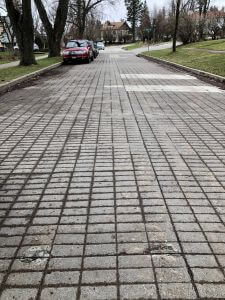"Ready Mixed Concrete" is a term used to describe concrete that is delivered in bulk and in its plastic (unhardened) state.
Sustainability for the ages!


Colorado Avenue (nka Irving Place) in Duluth paved with concrete in 1910 (photo from 2018).
Concrete is an ancient building material that can be found in nearly every feature of the built environment. It is almost impossible to imagine a world without concrete. We rely on it's availability, durability, and versatility for our streets, homes, schools, clinics, stores, offices, infrastructure, and so much more. It has been said that concrete is the most used material on earth, next to water.
Concrete and cement are NOT the same thing. Cement is to concrete, as flour is to cake. Cement typically refers to the binding (cementing) powder that is mixed with rock, sand, and water to create concrete. Only about a tenth of typical concrete is cement. The rest is air, water, admixtures, sand, and rock. In fact, about two-thirds to three-quarters of typical concrete is just rock and sand. You can learn more about how concrete is made from the Portland Cement Association (PCA).
In Minnesota, concrete has evolved to meet our special performance, climatic, and environmental demands. There are decades of research, education, and trials that lie behind every cubic yard of concrete that is batched. Today's concrete is as different from the concrete of the 1920s, as the cars of today are different from those of the 1920s.
Much of the current focus on technological advancements in concrete is aimed at sustainability, resilience, and climate change. The superior durability of concrete offers tremendous benefits for structures and infrastructure that must perform under the most severe climatic circumstances. Greater durability means less reconstruction or rehabilitation, which means less energy consumption and lower CO2 emissions.
The concrete industry in Minnesota, and throughout the world, is committed to lowering CO2 emissions that result from production and transportation of concrete. Ready mixed concrete in Minnesota includes some of the most advanced uses of recycled and low-carbon materials of any state in the U.S. We continue to look for, and to incorporate, solutions that will minimize emissions and still provide Minnesotans with a sustainable and versatile building material.
